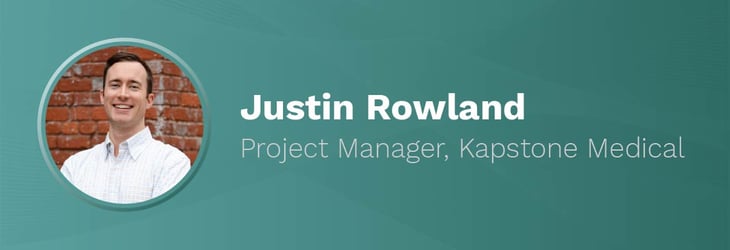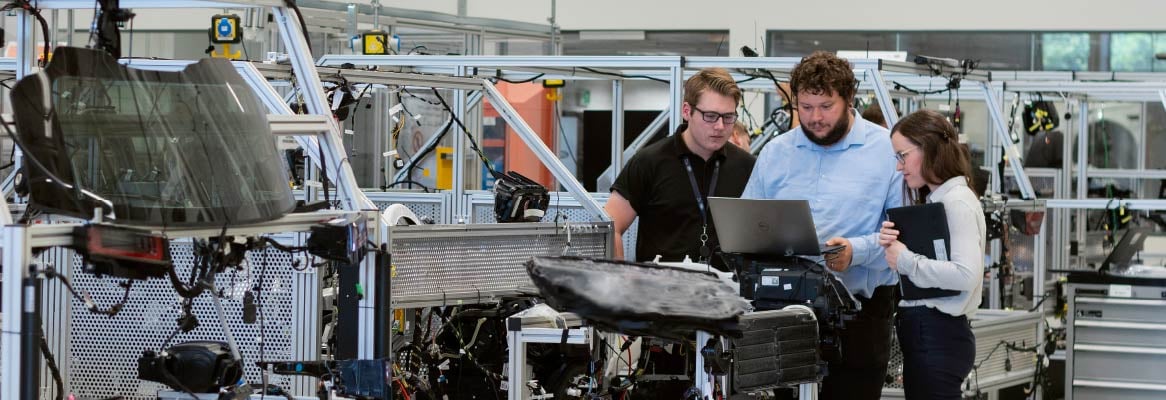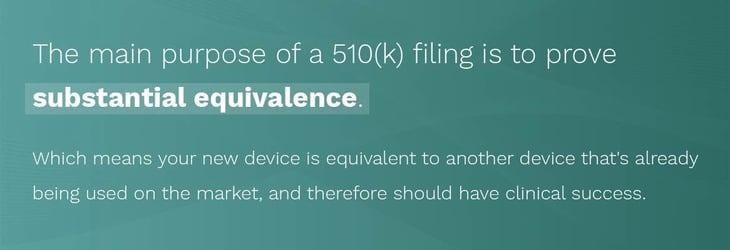A Conversation With Justin Rowland | Project Manager
Bringing a medical device to market is difficult for startup and established medical device companies alike. Though the development and approval process can sometimes take years, those years are jam-packed with requirements and milestones that can challenge even the most experienced companies.
Justin Rowland, Project Manager for Kapstone Medical, a medical device development and manufacturing company, is certainly familiar with the development challenges these companies face. He has been working in the field for years, and though he specializes in designing product, maintaining quality, and addressing regulations, his experience ranges across the medical device development lifecycle—and across the globe.
We recently sat down with Justin to discuss the most common challenges of medical device development, as well as how a Kapstone consultant can help to mitigate them.

1. Project Management
Bringing a new medical device to market starts with building the right team to handle all aspects of its development. Justin argues that businesses should think of these teams as the sum of their individual parts, with each part fulfilling a specific role or set of tasks. “I think the minimum is: have a project manager and at least a development engineer specific to each of the tentacles of the project,” he says. In other words, don’t be afraid to put the proper oversight in place. Having the right person assigned to each “tentacle” of the project will help your team ensure that the octopus, so to speak, comes together the way it should.
In addition to those core roles, every team should have a quality engineer and a regulatory specialist. The last position is vitally important, as regulatory requirements pose obstacles to even the most established medical device companies. These guidelines evolve constantly and differ between device types and locations, meaning there is no one-size-fits-all approach to regulatory adherence. Justin agrees, noting that regulatory affairs “is not something you can do part-time.”
But how do you find the right people for your project? Justin notes that companies don’t necessarily need to have these capabilities in-house. Kapstone consultants are trained in every aspect of medical device development and are “equipped to provide that entire team as needed.” Kapstone consultants “supplement and augment whatever team a company brings to the table,” working alongside that team at whichever amount is needed
Other project management tips:
- Schedule regular touch points for all team members to make sure the broader team is aligned
- Rely on centralized communication mechanisms, like distribution lists, chat services, and workflow platforms
- Remember that your team is composed of humans—they’re creating devices, but they can’t become them. They will make mistakes, and there will be things they don’t know. That’s okay. And that’s why it’s important to have a team of multiple people.

2. Budgeting
Budgeting is crucial to the success of any medical device project, no matter its size or industry. A natural consequence of the complexity of device development, Justin explains, is that businesses will “often underestimate the amount of time, resources, and finances that are needed for a project.” “Given that many have never gone through the process before,” Justin notes, “these companies just might not know which line items should be included on a budget. This leaves them vulnerable to underestimating the required costs.” Device startups in particular may be limited in their financial acumen and ability to project costs—though they more than make up for it in technical expertise!
Stealthily rising budgets (known in the industry as “scope creep”) are a problem everywhere. “Despite our best efforts, we just never know what’s going to come up,” Justin notes. He does offer some solace for startups, suggesting that some scope creep in the early design stages is completely natural and even expected. Working out the technical particulars of a product is an extremely intensive process, and may require starting from scratch at one point or another. That said, companies can certainly build out their budgets to accommodate the flexibility required in the design phase.
Kapstone consultants can assist with budgetary planning at the outset of a project, leveraging their expertise to determine how to scope for each phase of product development. They can also jump into an ongoing workstream and identify opportunities for cost savings. In fact, hiring a consultant can often be a form of cost savings in itself, as it prevents companies from having to outsource contractors and pay for multiple specialists— a business/financial analyst, a regulatory affairs expert, an engineer, a quality specialist, et cetera. The list can go on and on, but our consultants can check off everything on it.

3. Engineering
Just as in other fields, engineering issues in the medical device industry “revolve around the trifecta of time, quality, and price.” Things get a little more challenging for device companies in that the sector is “a bit niche, and can require specific materials, precision, and tolerance.” Some device companies have expertise in these areas, particularly if they are founded by people with engineering backgrounds. However, even the strongest engineering background is no match for complicated FDA regulations, meaning that companies should be prepared to adapt their modes of development.
So much goes into successful engineering of a medical device. Your company needs access to the right materials, and potentially a lot of them—particularly in the product development phase. You need to hire engineers who can work with those materials efficiently, safely, and cost-effectively. And those teams, as discussed above, need to stick to team schedules and be willing to adapt their procedures to adhere to changing regulatory guidance.
Unique to many medical products, you need to ensure that your device is biocompatible. This refers to a device’s ability to come into contact with the human body, for varying levels of duration and intrusiveness. Justin does note that this task is made a little easier by the fact that there are not many “true new materials” in medical device development. Rather, companies creating new devices will be manipulating existing materials in new ways, or with “a new process.”
Kapstone consultants are intimately familiar with the current landscape of biocompatible materials and processes. They understand every aspect of the niche medtech sector, and are able to leverage that expertise into strategic guidance for your company’s engineers. Whether we are recommending a materials supplier, helping engineers design tests for prototypes, or documenting material evidence for a regulatory submission, we bring efficiency and logic to the product development process.

4. FDA Regulatory Adherence
In the United States, FDA 510(k) submissions are the most common path to commercialization for Class II devices. These submissions can be highly complex and pose a significant challenge to startups and established companies alike. The main purpose of a 510(k) filing is to prove substantial equivalence, or that your new device is practically and technically the same as “another device that’s already being used on the market, and therefore should have clinical success” on that basis.
(Need more information about substantial equivalence or the 510(k) submission process? Check out our latest blog on the subject.)
Justin argues that in order to achieve this end goal of substantial equivalence, “the entire development team needs to understand it.” Everyone, from project managers to technical engineers, should plan milestones and protocols aimed at proving substantial equivalence to an existing product. “There are a number of different ways to show substantial equivalence,” Justin says, “including material, technology, indications for use, software, and perhaps even usability to a degree.” Ensuring that the project team is aware of these regulations “early on, so that they know what they’re designing and how they should set up tests", is essential to the success of a medical device project.
Kapstone consultants are experts in substantial equivalence and can assist in everything from designing products that achieve it to putting together the 510(k) submission that proves it. “It’s essential to have a regulatory expert like a Kapstone consultant on board,” Justin explains, in order to structure (or restructure) a project appropriately.
This challenge, as well as the others we have discussed, can pose significant roadblocks to medical device companies. Making the world a healthier place via the latest technology is no easy feat. However, with the strategic guidance of a Kapstone consultant, your company will be prepared to face those challenges and deliver lifesaving innovations to the patients who need them.
We’d love to join your team. Learn more about our approach and economical pricing or get in touch.



